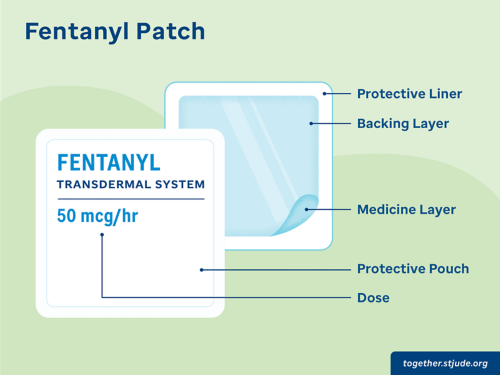Menu
Close
Back
Welcome to
Together is a new resource for anyone affected by pediatric cancer - patients and their parents, family members, and friends.
Learn More
Fentanyl patches are made with different dosages. Be sure you know the dose your child is prescribed.
Fentanyl (also called Duragesic®) is a medicine called an opioid or a narcotic. It is used to reduce pain. The fentanyl patch is a way of giving your child this pain medicine. When the patch is put on your child's skin, a small amount of the fentanyl is absorbed continuously through the skin.
The reason to give medicine through a patch is that your child will get the medicine continuously without having to swallow it or have an intravenous (IV) line.
Fentanyl patches are made with different dosages. Be sure you know the dose your child is prescribed.
You will need to change the patch every 72 hours (3 days). After 72 hours the patch stops giving enough of the fentanyl through the skin to relieve your child’s pain.
Some effects of the patch will continue for 18 hours after it is removed because the medicine has already been absorbed into the skin.
Put a new patch on a new area of skin every 72 hours (about 3 days). Change the patch at about the same time of day each time to give your child better pain control.
If a fentanyl patch falls off before the time to change it, replace it with a new patch. Remove it, fold the patch in half so the sticky side sticks to itself and dispose as instructed. If an existing patch is loose, follow the instructions to remove the old patch and replace it with a new one.
If you get some of the gel from the patch on your skin, wash your skin right away with running water. Do not use soap or alcohol to remove the gel, because that may make it easier for your skin to absorb the medicine. If you have any concerns about the medicine getting on your skin, call your doctor, nurse, or pharmacist.
All medicines have side effects. Some mild side effects of the fentanyl patch include:
More serious side effects include:
Contact your doctor if you notice any of the above symptoms.
If your child has any of these side effects, call 911. Then take the fentanyl patch off your child's skin.
Being exposed to fentanyl by accident can lead to harm or even death. Young children are at greatest risk. Patches must always be stored and used properly to prevent harm.
Follow these guidelines to protect everyone from fentanyl dangers:
Find more information on safe storage and disposal of medicines.
Always follow the instructions given by your care team. If you have questions about fentanyl patches, please talk to your child’s doctor, nurse, or pharmacist.
—
Reviewed: August 2022